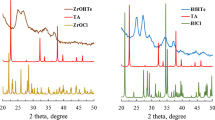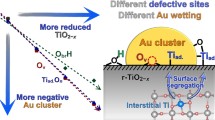Abstract
Three distinct approaches were used in the present work to investigate COS hydrolysis at metal oxide surfaces: (i) in situ FTIR spectroscopy, to provide information on the type of reaction intermediate species formed; (ii) reactivity measurements; (iii) quantum chemical calculations using ab initio Slater type orbital wavefunctions (STOP package) for COS and the semi-empirical GEOMOS-GREEN package, to give transition state structures and activation energy barrier heights. These three methods were found to be in excellent agreement. In particular, it is confirmed by FTIR and quantum chemical calculations that the COS hydrolysis mechanisms on Al2O3, TiO2 and ZrO2 are all of the type already published for the Al2O3 type I surface hydroxyl case. The relative activity hierarchy of these catalysts towards COS hydrolysis per unit area is: ZrO2≫Al2O3 >TiO2. This agrees with the amount of CO2 adsorbed in the form of hydrogen carbonate species measured by FTIR spectroscopy and the calculated barrier heights, more product-like C-O distance in the transition state and carbonyl charge. ZnO was investigated by FTIR spectroscopy and using GEOMOS. Both approaches indicate the formation of the monothiocarbonate adduct instead of hydrogen thiocarbonate species which explains the complete inactivity of ZnO for COS hydrolysis.
Similar content being viewed by others
References
R. Kettner and T. Lucke, Sulphur (1982) 707.
P.E. Hoggan, A. Aboulayt, A. Pieplu, P. Nortier and J.C. Lavalley, J. Catal. 149 (1994) 300.
S. Tan, C. Li, S. Liang and H. Guo, Catal. Lett. 8 (1991) 155.
H.M. Huisman, P. van der Berg, R. Mos, A.J. van Dillen and J.W. Geus, Appl. Catal A. 115 (1994) 157.
J. Bachelier, A. Aboulayt, J.C. Lavalley, O. Legendre and F. Luck, Catal. Today 17 (1993) 55.
C. Lahousse, A. Aboulayt, F. Maugé, J. Bachelier and J.C. Lavalley, J. Mol. Catal. 84 (1993) 283.
A. Bouferguene, M. Fares and P.E Hoggan, STOP 94, JQC Proc. 8 ICQC 73 Prague (1994).
D. Rinaldi, P.E. Hoggan and A. Cartier, GEOMOS, QCPE Bul. 9. No. 584 (1989).
A. Aboulayt, Thesis, Caen, France (1994).
J.C. Lavalley, Trends Phys. Chem. 2 (1991) 305.
A.A. Tsyganenko and V.N. Filimonov J. Mol. Struct. 19 (1973) 579.
P.E. Hoggan, DSc (1991).
M. Bensitel, O. Saur and J.C. Lavalley, Mat. Chem. Phys. 17 (1987) 249.
S.J. David and B.S. Ault, Inorg. Chem. 24 (1985) 1048.
P.E. Hoggan, M. Bensitel and J.C. Lavalley, J. Mol. Struct. 320 (1994) 49.
G. Busca and V. Lorenzelli, Mater. Chem. 7 (1982) 89.
J. Saussey and J.C. Lavalley, J. Chim. Phys. 75 (1978) 505.
K. Tanabe, M. Misono, Y. Ono and H. Hattori, eds.,New Solid Acids and Bases, Stud. Surf. Sci., Vol. 51 (Elsevier, Amsterdam, 1989) p. 74.
Author information
Authors and Affiliations
Rights and permissions
About this article
Cite this article
Aboulayt, A., Maugé, F., Hoggan, P.E. et al. Combined FTIR, reactivity and quantum chemistry investigation of COS hydrolysis at metal oxide surfaces used to compare hydroxyl group basicity. Catal Lett 39, 213–218 (1996). https://doi.org/10.1007/BF00805586
Received:
Accepted:
Issue Date:
DOI: https://doi.org/10.1007/BF00805586




